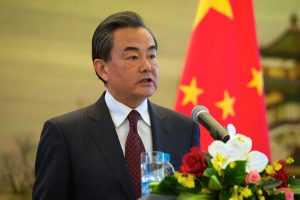China’s Foreign Minister Wang Yi today embarked on a fresh rota of diplomatic visits that will take him to three Southeast Asian nations, two of which recently hosted high-ranking U.S. officials including Vice President Kamala Harris.
Wang Yi’s weeklong trip began today in Vietnam, and will be followed by stops in Cambodia and Singapore. Wang will then fly on to South Korea on Tuesday and Wednesday, where he will hold talks with his local counterpart, Chung Eui-yong.
Not much of Wang’s agenda is clear, but for what it’s worth, a Chinese foreign ministry spokesperson said earlier this week that the visits embodied “the great emphasis China attaches to and its sincere hope of enhancing friendly relations and deepening mutually-beneficial cooperation with the four countries.”
According to the spokesperson, the talks in all four nations will “focus on anti-epidemic and development cooperation, seek greater synergy between China’s endeavor to foster a new development paradigm and the four countries’ development strategies, and deepen BRI cooperation and the building of a community with a shared future for mankind.”
Wang’s Southeast Asia stops are intended to build on a year of concerted outreach to the 10 member states of the Association of Southeast Asian Nations (ASEAN). Prior to this trip he had visited nine of the 10 ASEAN nations over the past year (Vietnam was the outlier), while four Southeast Asian foreign ministers visited China in late March and early April. Wang then hosted all 10 ASEAN foreign ministers in Chongqing in June.
All of this has taken place amid a belated diplomatic campaign by the new Biden administration to engage the nations of Southeast Asia. In recent months three senior U.S. officials have visited Southeast Asia, most recently U.S. Vice President Kamala Harris last month, Defense Secretary Lloyd Austin in July, and Wendy Sherman, the deputy secretary of state, in late May and early June.
During their visits, both Austin and Harris reinforced the U.S. commitment to the nations contesting China’s expansive claims in the South China Sea. While in Manila, Austin also secured a retraction of Philippine President Rodrigo Duterte’s decision to terminate the Visiting Forces Agreement, an important part of the U.S.-Philippine alliance.
Wang’s itinerary likely reflects a Chinese interest in countering these recent U.S. moves and shoring up relations with nations that it views as central to its “neighborhood diplomacy.” Singapore and Vietnam both figured on the itineraries of Harris and Austin, reflecting the fact that Washington views them as its most productive partners in the region, and it is unsurprising the Wang would want to follow up.
Cambodia’s presence on Wang’s itinerary is also par for the course, given the intimate and mutually beneficial relationship that has grown up between Beijing and Phnom Penh in recent years.
Buried under the diplomatic boilerplate about “a shared community of mankind,” Chinese diplomats have had a fairly simple message for Southeast Asian governments: China is in the region; the United States isn’t.
Beijing has also tried to tune its outreach to the public health challenges posed by the COVID-19 pandemic, which is surging in many Southeast Asian countries, and presented China as an inexorable partner for the region as it seeks to restart economic growth. Indeed, today Cambodia’s Prime Minister Hun Sen gave an address at the 18th China-ASEAN Expo in which he effusively thanked China for “its leading role in the fight against the COVID-19 at the global level.”
At the same time, proximity is also a source of angst for the nations of Southeast Asia. While the region appreciates Chinese support as it struggles to shrug off its current COVID-19 slump, vaccines and promises of further “development cooperation” will not neutralize the consternation that many governments in the regions feel – particularly those facing the hard edge of Chinese power in the South China Sea. All this will ensure the region will continue look further afield, including to the U.S., as China’s relative power continues to grow.

































